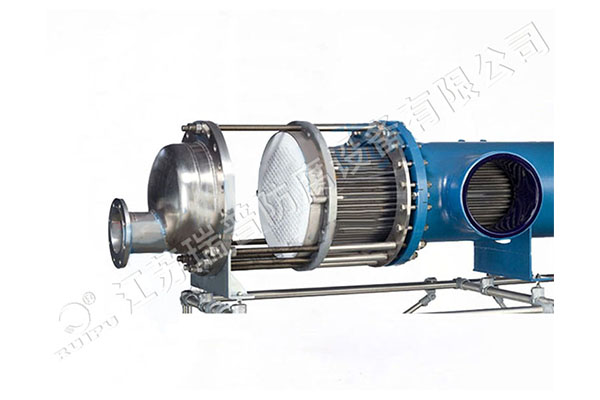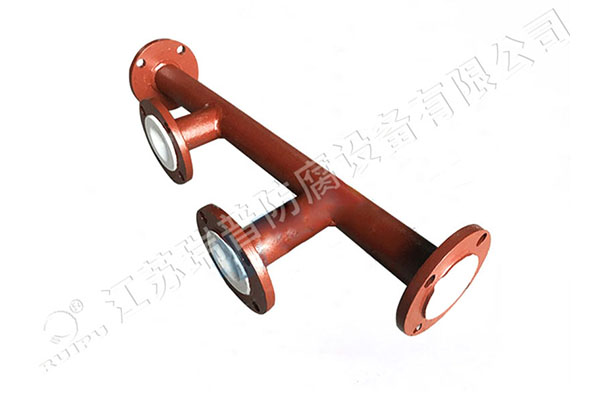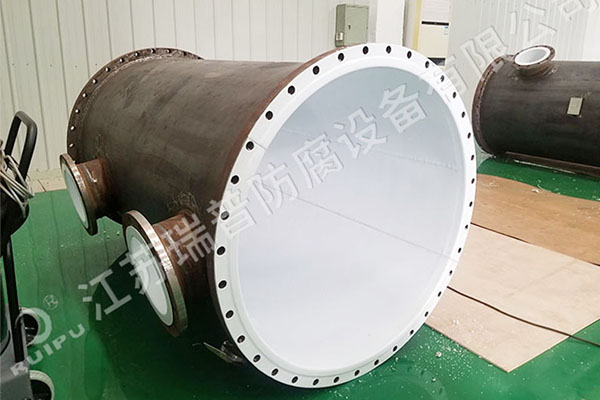What are the advantages of the non-lapped lining structure of steel lined PTFE tower sections and storage tanks in preventing leakage?
Release Time : 2025-07-24
In the production process of chemical, pharmaceutical and other industries, the anti-corrosion performance of the equipment is directly related to the continuity and safety of production. As a high-performance anti-corrosion material, steel lined PTFE tower sections and storage tanks have demonstrated excellent anti-leakage capabilities in many application scenarios.
1. Seamless connection reduces potential leakage points
Traditional lining materials are usually installed by splicing multiple plates, which inevitably forms weak links at the joints. Even after fine welding or bonding, these joints may still become the main source of penetration and leakage of corrosive media. In contrast, steel lined PTFE tower sections and storage tanks use advanced hot spinning technology to achieve seamless molding, thereby completely eliminating the potential leakage risks caused by traditional splicing methods. There is no overlap on the entire lining layer, which ensures the uniform flow of fluid throughout the channel and avoids ruptures or gaps caused by local stress concentration.
2. Improve the anti-permeability and enhance the sealing effect
Steel lined PTFE tower sections and storage tanks are not only smooth and flat in appearance, but more importantly, their internal structure is tight and there are almost no tiny holes or bubbles. This is due to the high-quality imported raw materials and precise production process control. PTFE itself has extremely low surface energy and excellent chemical inertness, which means that it is highly resistant to most acid, alkali and salt solutions, organic solvents and other corrosive media. In addition, since the lining layer and the steel substrate are tightly combined through hot melt technology to form a whole, the anti-permeability performance of the system is greatly enhanced. Therefore, even in the face of long-term exposure to a highly corrosive environment, steel lined PTFE tower sections and storage tanks can maintain a good sealing effect and eliminate any possible leakage.
3. Adapt to temperature changes and prevent cracking caused by thermal expansion and contraction
Chemical production is often accompanied by drastic temperature fluctuations, which places strict requirements on the temperature resistance and dimensional stability of the equipment. After experiencing frequent heating and cooling cycles, ordinary lining materials are prone to inconsistent thermal expansion and contraction, which in turn leads to gaps and even cracks between the lining layer and the substrate. However, the uniqueness of steel lined PTFE tower sections and storage tanks lies in its design concept of integrated steel and plastic molding, which enables the plastic and metal matrix to expand or contract synchronously under the same conditions, effectively avoiding the delamination problem caused by the large difference in thermal expansion coefficient between the materials. This feature significantly improves the overall reliability of the equipment, extends its service life, and can still maintain a stable sealing state under extreme working conditions.
4. Improve mechanical strength and resist external impact
In addition to its excellent anti-corrosion performance, steel lined PTFE tower sections and storage tanks also have high mechanical strength and can withstand a certain degree of external impact without damage. Especially in some occasions where handling or installation conditions are harsh, such as high-altitude operations or assembly work in a small space, the equipment will inevitably suffer accidental collisions. At this time, if ordinary soft lining materials are used, it is very easy to cause damage to the lining and cause leakage. The steel lined PTFE tower sections and storage tanks, with their rugged and durable characteristics, can not only resist external physical damage, but also ensure the safe transportation of internal media, further reducing the possibility of leakage accidents.
5. Optimize design to meet the needs of complex working conditions
Modern chemical plants are increasingly becoming large-scale and integrated, which requires that the supporting anti-corrosion equipment must be flexible enough to cope with various complex operating conditions. Steel lined PTFE tower sections and storage tanks can be customized according to the specific needs of users. Products of different specifications and shapes can be accurately matched, whether they are straight pipe sections or special-shaped components. At the same time, the product also supports the addition of special functions, such as adding static conductive coatings to prevent safety hazards caused by static electricity accumulation; or using multi-layer composite structures to further enhance the protection level. All these design improvements are to minimize the risk of leakage and ensure production safety.
In summary, steel lined PTFE tower sections and storage tanks have many irreplaceable advantages in preventing leakage with their unique non-lapped lining structure. From seamless connection to high permeability resistance, to adapting to temperature changes and improving mechanical strength, each feature plays an important role in practical applications.
1. Seamless connection reduces potential leakage points
Traditional lining materials are usually installed by splicing multiple plates, which inevitably forms weak links at the joints. Even after fine welding or bonding, these joints may still become the main source of penetration and leakage of corrosive media. In contrast, steel lined PTFE tower sections and storage tanks use advanced hot spinning technology to achieve seamless molding, thereby completely eliminating the potential leakage risks caused by traditional splicing methods. There is no overlap on the entire lining layer, which ensures the uniform flow of fluid throughout the channel and avoids ruptures or gaps caused by local stress concentration.
2. Improve the anti-permeability and enhance the sealing effect
Steel lined PTFE tower sections and storage tanks are not only smooth and flat in appearance, but more importantly, their internal structure is tight and there are almost no tiny holes or bubbles. This is due to the high-quality imported raw materials and precise production process control. PTFE itself has extremely low surface energy and excellent chemical inertness, which means that it is highly resistant to most acid, alkali and salt solutions, organic solvents and other corrosive media. In addition, since the lining layer and the steel substrate are tightly combined through hot melt technology to form a whole, the anti-permeability performance of the system is greatly enhanced. Therefore, even in the face of long-term exposure to a highly corrosive environment, steel lined PTFE tower sections and storage tanks can maintain a good sealing effect and eliminate any possible leakage.
3. Adapt to temperature changes and prevent cracking caused by thermal expansion and contraction
Chemical production is often accompanied by drastic temperature fluctuations, which places strict requirements on the temperature resistance and dimensional stability of the equipment. After experiencing frequent heating and cooling cycles, ordinary lining materials are prone to inconsistent thermal expansion and contraction, which in turn leads to gaps and even cracks between the lining layer and the substrate. However, the uniqueness of steel lined PTFE tower sections and storage tanks lies in its design concept of integrated steel and plastic molding, which enables the plastic and metal matrix to expand or contract synchronously under the same conditions, effectively avoiding the delamination problem caused by the large difference in thermal expansion coefficient between the materials. This feature significantly improves the overall reliability of the equipment, extends its service life, and can still maintain a stable sealing state under extreme working conditions.
4. Improve mechanical strength and resist external impact
In addition to its excellent anti-corrosion performance, steel lined PTFE tower sections and storage tanks also have high mechanical strength and can withstand a certain degree of external impact without damage. Especially in some occasions where handling or installation conditions are harsh, such as high-altitude operations or assembly work in a small space, the equipment will inevitably suffer accidental collisions. At this time, if ordinary soft lining materials are used, it is very easy to cause damage to the lining and cause leakage. The steel lined PTFE tower sections and storage tanks, with their rugged and durable characteristics, can not only resist external physical damage, but also ensure the safe transportation of internal media, further reducing the possibility of leakage accidents.
5. Optimize design to meet the needs of complex working conditions
Modern chemical plants are increasingly becoming large-scale and integrated, which requires that the supporting anti-corrosion equipment must be flexible enough to cope with various complex operating conditions. Steel lined PTFE tower sections and storage tanks can be customized according to the specific needs of users. Products of different specifications and shapes can be accurately matched, whether they are straight pipe sections or special-shaped components. At the same time, the product also supports the addition of special functions, such as adding static conductive coatings to prevent safety hazards caused by static electricity accumulation; or using multi-layer composite structures to further enhance the protection level. All these design improvements are to minimize the risk of leakage and ensure production safety.
In summary, steel lined PTFE tower sections and storage tanks have many irreplaceable advantages in preventing leakage with their unique non-lapped lining structure. From seamless connection to high permeability resistance, to adapting to temperature changes and improving mechanical strength, each feature plays an important role in practical applications.







